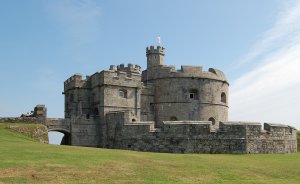
Pendennis Head, Falmouth, TR11 4LP
Tel: (01326) 316594
Email: southwest@english-heritage.org.uk
Web: www.english-heritage.org.uk/visit/places/pendennis-castle
Web: www.visitcornwall.com/things-to-do/family-attractions/pendennis-castle
A fine and mighty fortress
King Henry VIII was so determined to prevent the French from attacking his shores he built a chain of castles all along the south coast. Pendennis, built in 1539, is part of that chain.
Sir John Killigrew (1516-1567) of Arwenack House was the first Governor of Pendennis Castle, it was situated on land within the Arwenack estate on the tip of a peninsula about one mile south-east of Arwenack House, and was appointed by King Henry VIII.
In 1598, during Elizabeth I's reign, a new type of defensive wall was added around the original fort. The castle was strengthened again in 1627 with more defences added prior to the Civil War and played host to the future Charles II in 1646, before he sailed to the Isles of Scilly. Under the command of Sir John Arundell and Sir William Killigrew (1606-1695), it then withstood five months of siege with a 1000 troops garrisoned inside, before becoming the penultimate Royalist garrison on the British mainland to surrender on the 17th August 1646.
During the First World War the castle formed part of a system of coastal batteries protecting Falmouth. Finally in 1956 the military moved out and the Ministry of Works took over to maintain the castle as an ancient monument.
Pendennis overlooks the mile-wide mouth of the River Fal. at the most westerly point where it was possible to anchor safely. It is difficult to imagine today, when visiting the popular holiday area of Cornwall, how wild and remote this beautiful part of the coast used to be.
But the massive walls, rambling rooms and stone staircases of Pendennis make it easy to imagine the scenes of bloody conflict 350 years ago.
An exhibition in the old gun room helps you experience almost at first hand the sights and sounds of a Tudor battle. And there are artefacts from the Second World War, when Pendennis was again called into action.
Noonday Gun is fired every day at noon during July and August. World War II Observation Post reconstruction shows how a warning of an enemy attack was given. And you can descend through secret underground tunnels to the big guns of Half Moon battery and take a guided tour of the underground magazines.
Pendennis Castle is now managed by English Heritage.
Pendennis Castle Restaurant. The castle tearoom in the Royal Garrison Artillery Barracks which serves up food with views of the keep and the sea beyond. Full of seasonal Cornish ingredients, with regulars like Cornish pasties, soup of the day, freshly made sandwiches and Ploughman’s lunches, as well as our Catch of the Day special.
On the southern most edge of the town and almost completely surrounded by the sea.
Opening Times22nd March - 30th September: Daily, 10.00am - 6.00pm Facilities Admission Charged |
Launceston Castle Restormel Castle St. Mawes Castle Tintagel Castle Trematon Castle
Arwenack House Falmouth Cornwall's History English Heritage in Cornwall